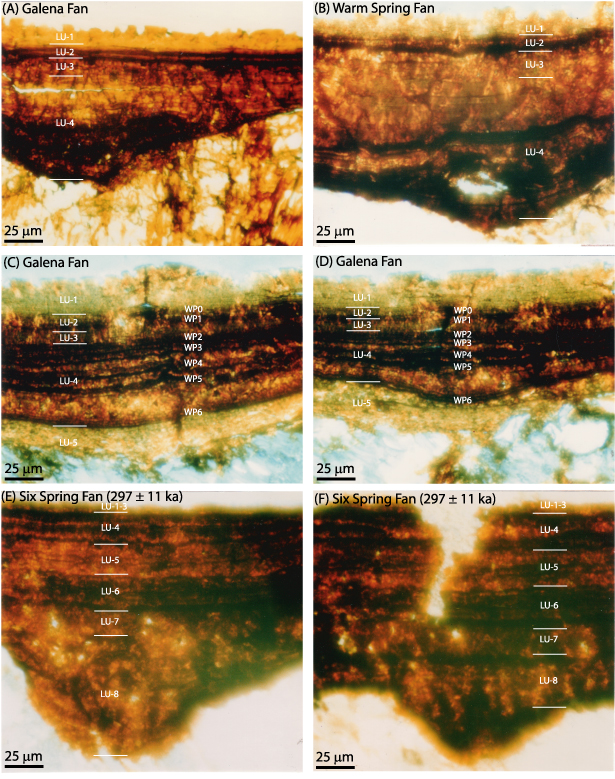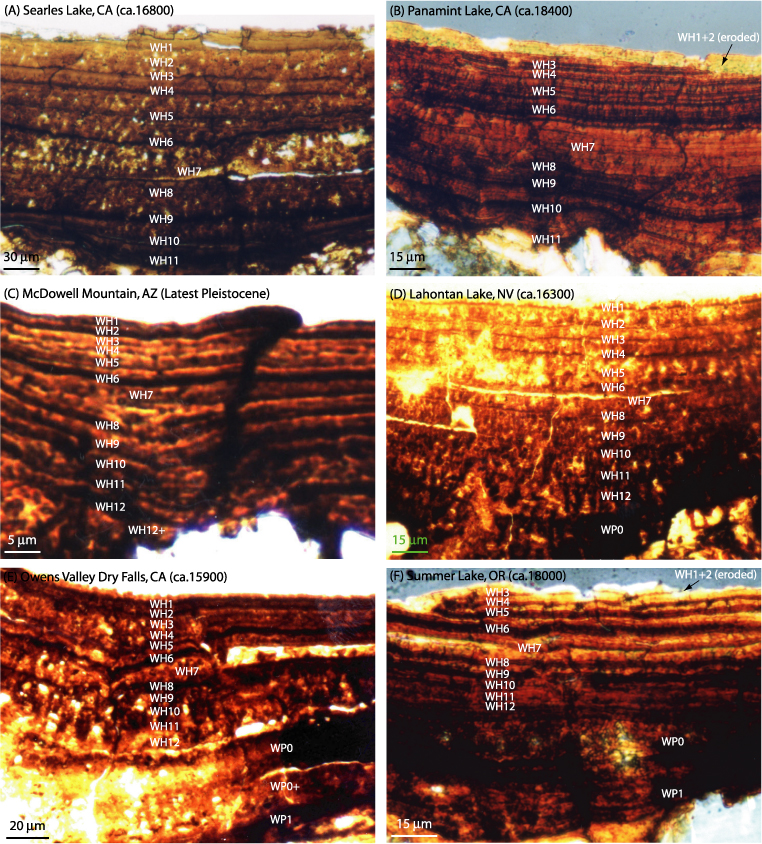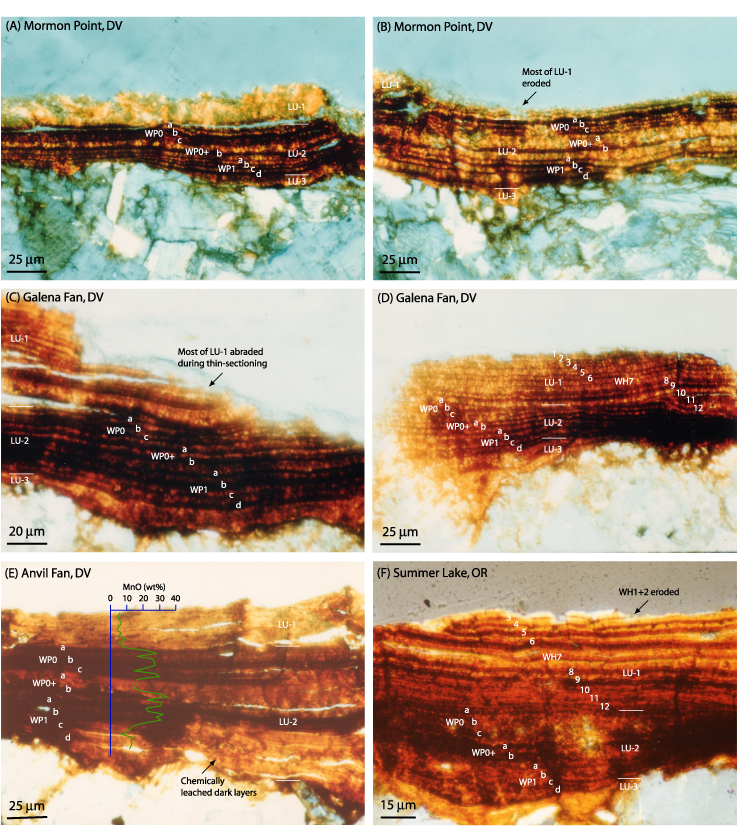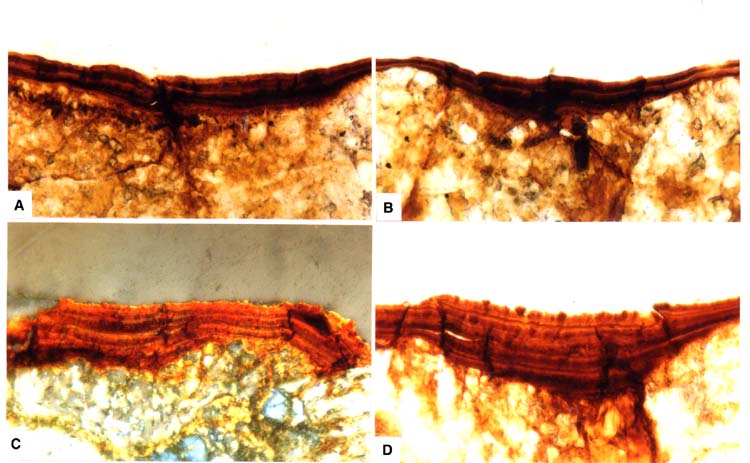
| (A) | (B) |
| (C) | (D) |
Figure Caption Varnish microstratigraphies from (A) Patagonia Desert, Argentina; (B) Gürbantongüt Desert, western China; (C) Negev Desert, Israel; and (D) Mojave Desert, western USA. These samples were collected from various geomorphic surfaces of latest Pleistocene age (i.e., 11500-18000 cal yr BP). Maximum varnish thicknesses (in µm) are 80 (A), 45 (B), 100 (C), 120 (D).

Figure Caption Regionally replicated late Pleistocene varnish microstratigraphies in the drylands of western USA. Varnish samples were collected from late Pleistocene alluvial-fan surfaces in Death Valley, California. Age constraints for (E) and (F) are from cosmogenic Be-10 measurements on the sampled varnished alluvial boulders. LU = Layering Unit, and WP = Wet event in Pleistocene. LU-1 represents the Holocene.

Figure Caption Regionally replicated Holocene varnish microstratigraphies in the drylands of western USA. Varnish samples in (A), (B), (D), and (F) were from latest Pleistocene highstand shorelines of Searles Lake, Panamint Lake, Lahontan Lake, and Summer Lake. Varnish in (C) was from latest Pleistocene alluvial-fan surfaces in McDowell Mountain of Arizona, and the one in (E) from the Dry Falls of Owens Valley, California. These fast-growing and younger varnishes were intentionally collected from the older latest Pleistocene geomorphic furfaces for observation of a complete Holocene varnish microstratigraphy. Age constraints are maximum-limiting ages for varnish formation (reported in cal yr BP). WH = Wet event in Holocene, and WP = Wet event in Pleistocene.

Figure Caption Regionally replicated latest Pleistocene and Holocene varnish microstratigraphies in the drylands of western USA. Varnish in (A) and (B) was from the lowstand shorelines of late Pleistocene Lake Manly at Mormon Point, Death Valley. Varnish in (C) through (E) was from late Pleistocene alluvial-fan surfaces in Galena Canyon and Anvil Canyon, Death Valley. Varnish in (F) was from the highstand shorelines of late Pleistocene Summer Lake, Oregon. Some of these fast-growing and highly-sensitive varnish microbasins recorded both latest Pleistocene and Holocene millennial-scale wet events in the drylands of western USA. Note that there are some post-depositional modifications such as surface peeling and erosion that resulted in both conformal and angular unconformities in these microstratigraphies. Also note that a large portion of the Holocene varnish microstratigraphy (i.e., LU-1) in (C) was mechanically abraded during ultra-thin sectioning of varnish sample. The Mn-rich basal dark layers (i.e., WP1a-d) in (E) have been altered into Mn-intermediate orange layers at the center to right portion of the varnish microbasin due to postdepositional chemical leaching. DV = Death Valley, OR = Oregon, LU = Layering Unit, WH = Wet event in Holocene, and WP = Wet event in Pleistocene.

Figure Caption Regionally replicated microstratigraphies in varnish samples from the north flank of Tian Shan in the Gürbantongüt Desert, western China. (A) and (B): varnish from I-2 terrace surfaces of Hutubi He, 6.5 m above the active washes and probably of latest Pleistocene/early Holocene age. (C) and (D): varnish from I-3 terrace surfaces of Hutubi He, 9 m above the active washes and probably of latest Pleistocene age. The two dark layers in (A) and (B) and the upper two dark layers in (C) and (D) likely represent early and late Holocene wet phases that occurred at 8.0-6.0 and 4.5-2.5 C-14 ka, respectively, in the region. Maximum varnish thicknesses (in µm) are 25 (A, B), 40 (C), and 50 (D).
| (A) | (B) |
| (C) | (D) |
Figure Caption Regionally replicated microstratigraphies in varnish samples from the west bank of the Dead Sea Rift, Israel. (A) and (B): Varnish from lower post-Lisan shorelines at Nahal Darga. (C) and (D): Varnish from higher post-Lisan shorelines at Nahal Zeelim. The dark layers in the lower portions of the varnish microstratigraphies in (A) and (B) likely represent early Holocene wet phases in the region, and the two dark layers in the lower portions of the varnish microstratigraphies in (C) and (D) likely represent latest Pleistocene Younger Dryas-aged wet phases. Maximum varnish thicknesses (in µm) are 70 (A), 90 (B), 55 (C), and 50 (D).
| (A) | (B) |
| (C) | (D) |
Figure Caption Regionally replicated microstratigraphies in varnish samples from the Patagonia Desert, Argentina. (A) and (B): Varnish from morainal boulders in Rio Mendoza Valley. (C) and (D): Varnish from morainal boulders in Rio Atuel Valley. The dark layers in the upper portions of the varnish microstratigraphies in (A) and (B) likely represent late Holocene Neoglacial wet phases in the region, and the two dark layers in the lower portions of the varnish microstratigraphies in (A) through (D) likely represent latest Pleistocene wet phases. Maximum varnish thicknesses (in µm) are 80 (A), 90 (B), 50 (C), and 55 (D).
| (A) | (B) |
| (C) | (D) |
Figure Caption Varnish microstratigraphies from early-to-middle Holocene alluvial-fan surfaces near Beltana, South Australia. Maximum varnish thicknesses (in µm) are 125 (A), 125 (B), 85 (C), and 100 (D).
| (A) | (B) |
| (C) | (D) |
Figure Caption Varnish microstratigraphies from the Indus River Valley, Pakistan. (A) and (B): Varnish from bedrock surfaces on the north bank of the Indus River near Skardu. (C) and (D): Varnish from bedrock surfaces near Chilas. Maximum varnish thicknesses (in µm) are 40 (A), 50 (B), 120 (C), and 70 (D).